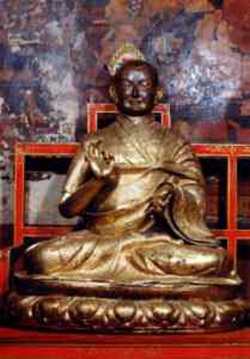Difference between revisions of "Buddhabhadra (translator)"
(Created page with " Buddhabhadra (translator) Buddhabhadra; byang chub bzang po - Bodhibhadra [RY] Buddhabhadra (simplified {{Wiki|Chinese}}: 佛陀跋陀罗; {{Wiki...") |
|||
| Line 1: | Line 1: | ||
| + | [[File:Pandita Gayadhara.JPG|thumb|250px|]] | ||
| + | <poem> | ||
[[Buddhabhadra (translator)]] | [[Buddhabhadra (translator)]] | ||
| Line 6: | Line 8: | ||
[[Buddhabhadra]] and his {{Wiki|Chinese}} [[disciple]] [[Xuangao]] are known to have advocated the twin {{Wiki|principles}} of [[samadhi]] ([[meditative concentration]]) and [[prajna]] ([[transcendent wisdom]]). These were later inherited by the [[Tiantai school]] of [[Buddhism]], and its [[patriarchs]] [[Huisi]] and [[Zhiyi]]. [[Buddhabhadra's]] [[views]] in turn stemmed from those of [[Buddhasena's]] [[Dhyāna school]] in [[Kashmir]], and their [[meditation manual]] was translated by [[Buddhabhadra]] at behest of [[Huiyuan]], the founder of the {{Wiki|Chinese}} [[tradition]] of [[Pure Land Buddhism]]. This [[Indian]] [[meditation manual]] preserved in [[Taisho Tripitaka]] 618, and is typically called the [[Yogacarabhumi Sutra]] or the [[Dharmatrata Dhyana Sutra]]. This text was later prized by the [[Zen school]] in [[China]], and parts of its [[lineage]] to the [[Buddha]] became entangled in {{Wiki|sectarian}} conflicts between factions of [[Chinese Buddhism]]. | [[Buddhabhadra]] and his {{Wiki|Chinese}} [[disciple]] [[Xuangao]] are known to have advocated the twin {{Wiki|principles}} of [[samadhi]] ([[meditative concentration]]) and [[prajna]] ([[transcendent wisdom]]). These were later inherited by the [[Tiantai school]] of [[Buddhism]], and its [[patriarchs]] [[Huisi]] and [[Zhiyi]]. [[Buddhabhadra's]] [[views]] in turn stemmed from those of [[Buddhasena's]] [[Dhyāna school]] in [[Kashmir]], and their [[meditation manual]] was translated by [[Buddhabhadra]] at behest of [[Huiyuan]], the founder of the {{Wiki|Chinese}} [[tradition]] of [[Pure Land Buddhism]]. This [[Indian]] [[meditation manual]] preserved in [[Taisho Tripitaka]] 618, and is typically called the [[Yogacarabhumi Sutra]] or the [[Dharmatrata Dhyana Sutra]]. This text was later prized by the [[Zen school]] in [[China]], and parts of its [[lineage]] to the [[Buddha]] became entangled in {{Wiki|sectarian}} conflicts between factions of [[Chinese Buddhism]]. | ||
| + | </poem> | ||
| + | {{W}} | ||
| + | [[Category:Chinese Buddhism]] | ||
Latest revision as of 02:27, 27 December 2014
Buddhabhadra (translator)
Buddhabhadra; byang chub bzang po - Bodhibhadra [RY] Buddhabhadra (simplified Chinese: 佛陀跋陀罗; traditional Chinese: 佛陀跋陀羅; pinyin: Fótuóbátuóluó) (359-429 CE) was an Indian Buddhist monk, with the title of śramaṇa. He is most known for his prolific translation efforts of Buddhist texts from Sanskrit into Chinese, and was responsible for the first Chinese translation of the Avataṃsaka Sūtra (Flower Ornament Scripture) in the 5th century CE.[2]
Buddhabhadra and his Chinese disciple Xuangao are known to have advocated the twin principles of samadhi (meditative concentration) and prajna (transcendent wisdom). These were later inherited by the Tiantai school of Buddhism, and its patriarchs Huisi and Zhiyi. Buddhabhadra's views in turn stemmed from those of Buddhasena's Dhyāna school in Kashmir, and their meditation manual was translated by Buddhabhadra at behest of Huiyuan, the founder of the Chinese tradition of Pure Land Buddhism. This Indian meditation manual preserved in Taisho Tripitaka 618, and is typically called the Yogacarabhumi Sutra or the Dharmatrata Dhyana Sutra. This text was later prized by the Zen school in China, and parts of its lineage to the Buddha became entangled in sectarian conflicts between factions of Chinese Buddhism.
